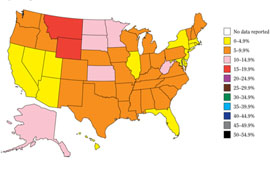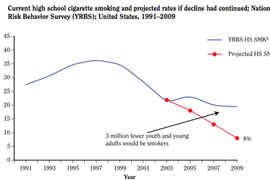Cronkite News has moved to a new home at cronkitenews.azpbs.org. Use this site to search archives from 2011 to May 2015. You can search the new site for current stories.
Arizona among best in the nation for reducing tobacco use
WASHINGTON – Arizona is one of the better states in the nation when it comes to preventing tobacco use among 12- to 25-year-olds, according to a report released Thursday by the Surgeon General.
The state has one of the lowest rates for minors using smokeless tobacco, the report said, and is in a group of 11 states with the lowest rate of cigarette use by 18- to 25-year-olds.
The report had particular praise for anti-tobacco efforts in Utah and California, where youth smoking rates between 2006 and 2010 were less than 25 percent and less than 30 percent, respectively. Arizona’s rate of young adult smokers during the same period was between 30 and 35 percent, along with eight other states.
But Arizona has made “some progress” in the level of youth tobacco consumption, said Wayne Tormala, chief of the tobacco and chronic disease bureau for the Arizona Department of Health Services, even though he admitted more needs to be done.
He said Arizona has mirrored the nation, where steady declines in tobacco use by youths and young adults that began in 1997 have slowed or stalled in recent years.
Despite the progress in cutting tobacco use – in addition to the relatively low number of young smokers, the number of youth using smokeless tobacco in Arizona hovers around 1 percent – Tormala said there are still areas that need improvement. That is particularly true of efforts to stop young people from experimenting with tobacco in the first place.
For each of the roughly 1,200 smoking-related deaths every day, at least two youths or young adults become regular smokers, a rate the report calls a “pediatric epidemic.” It said that 88 percent of adult smokers start by age 18 and 99 percent start by age 26.
“For many youth, it’s the beginning of a lifetime commitment – by the way, it would be a much shorter life,” Tormala said. “Most youth, if they’re smoking, are convinced they’ll quit before they become adults.”
He said Arizona spent more than $15 million last year on tobacco control and prevention, about one-third of which went toward prevention efforts such as the state’s “Venomocity” campaign, which targets youth prevention by focusing on nicotine addiction. Tormala said there are plans to increase prevention funding this year.
But some say Arizona could do more.
The Centers for Disease Control and Prevention recommended that Arizona spend $68.1 million on tobacco prevention and control in fiscal 2012, compared to the $18 million actually spent – numbers that earned the state a grade of F in the American Lung Association’s annual report.
Bill Pfeifer, president and CEO of American Lung Association of the Southwest, said the state “could be and should be doing a lot better.”
“I’m sure the state health department feels they have been doing a good job,” Pfeifer said. “But we could probably argue that if they had an extra $20 million they could be even more effective.”
Tormala called the CDC’s spending recommendation appreciated, but unrealistic.
“The big issue nationally is that so many states have had their budgets cut, so the levels of (tobacco-control) program activity in both youth and adults have really been cut drastically,” Tormala said. “We have not experienced dramatic cuts.”
Arizona is one of a few states with a tobacco-control program funded by a voter-approved tobacco tax – $2 per pack of cigarettes.
Tormala said the “one-two punch” of raising the cost of smoking and sending that money toward prevention has proven to be successful. But he noted that as the state cuts tobacco use, there will be less cigarette tax money coming in for tobacco-control funding.
Pfeifer said the tobacco tax has helped, along with a 2006 law banning smoking in enclosed public places and workplaces, but that the state needs to keep moving forward.
“We’re really proud of what we were able to accomplish in Arizona over the years, but the last thing we want to do is rest,” Pfeifer said. “It (tobacco use) can easily rear its ugly head . . . We need to not let up.”
Tormala said the health department is looking to continue improving tobacco control and prevention by “building linkages between different systems” and working with local governments to boost treatment.
“We know tobacco use is still the number-one preventable cause of death, so we can’t afford to take our eye off of it,” he said.









